
North Korea is located in East Asia on the Northern half of the Korean Peninsula.

South Korea is located in East Asia, on the southern half of the Korean Peninsula located out from the far east of the Asian landmass. The only country with a land border to South Korea is North Korea, lying to the north with 238 kilometres (148 mi) of border running along the Korean Demilitarized Zone. South Korea is mostly surrounded by water and has 2,413 kilometres (1,499 mi) of coastline along three seas; to the west is the Yellow Sea, to the south is the East China Sea, and to the east is the Sea of Japan. Geographically, South Korea's land mass is approximately 100,032 square kilometres (38,623 sq mi). 290 square kilometres (110 sq mi) of South Korea are occupied by water. The approximate coordinates are 37° North, 127° 30 East.

Paektu Mountain, also known as Baekdu Mountain, and in China as Changbai Mountain, is an active stratovolcano on the Chinese–North Korean border. At 2,744 m (9,003 ft), it is the highest mountain of the Changbai and Baekdudaegan ranges. Koreans assign a mythical quality to the volcano and its caldera lake, considering it to be their country's spiritual home. It is the highest mountain in North Korea, the Korean Peninsula, and Northeast China.
This is a list of articles on Korea-related people, places, things, and concepts. For help on how to use this list, see the introduction below.

Dangun or Dangun Wanggeom was the legendary founder and god-king of Gojoseon, the first Korean kingdom, around present-day Liaoning, Manchuria, and the northern part of the Korean Peninsula. He is said to be the "grandson of heaven" and "son of a bear", and to have founded the kingdom in 2333 BC. The earliest recorded version of the Dangun legend appears in the 13th-century Samguk Yusa, which cites China's Book of Wei and Korea's lost historical record Gogi.
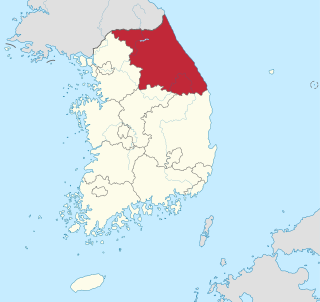
Gangwon-do is a province of South Korea, with its capital at Chuncheon. It is bounded on the east part by the East Sea, and borders Gyeonggi Province to its west, and North Gyeongsang Province and North Chungcheong Province to its south. Its northern boundary is the Military Demarcation Line, separating it from North Korea's Kangwŏn Province. Before the division of Korea in 1945 Gangwon and Kangwŏn formed a single province. Pyeongchang County hosted the 2018 Winter Olympics and 2018 Winter Paralympics.
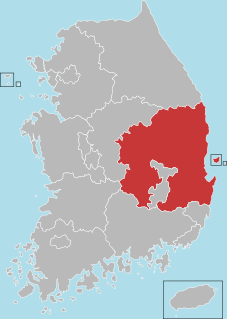
North Gyeongsang Province, also known as Gyeongbuk, is a province in eastern South Korea. The province was formed in 1896 from the northern half of the former Gyeongsang province, and remained a province of Korea until the country's division in 1945, then became part of South Korea.
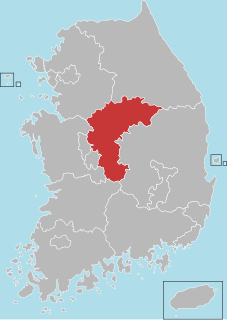
North Chungcheong Province, also known as Chungbuk, is a province of South Korea. North Chungcheong has a population of 1,578,934 (2014) and has a geographic area of 7,433 km2 located in the Hoseo region in the south-center of the Korean Peninsula. North Chungcheong borders the provinces of Gyeonggi and Gangwon to the north, North Gyeongsang to the east, North Jeolla to the south, and South Chungcheong, Sejong Special Autonomous City, and Daejeon Metropolitan City to the west.

Gyeonggi Province is the most populous province in South Korea. Its name, Gyeonggi, means "the area surrounding the capital". Thus Gyeonggi-do can be translated as "province surrounding Seoul". The provincial capital is Suwon. Seoul—South Korea's largest city and national capital—is in the heart of the province but has been separately administered as a provincial-level special city since 1946. Incheon—South Korea's third-largest city—is on the coast of the province and has been similarly administered as a provincial-level metropolitan city since 1981. The three jurisdictions are collectively referred to as Sudogwon and cover 11,730 km2 (4,530 sq mi), with a combined population of 25.5 million—amounting to over half of the entire population of South Korea.
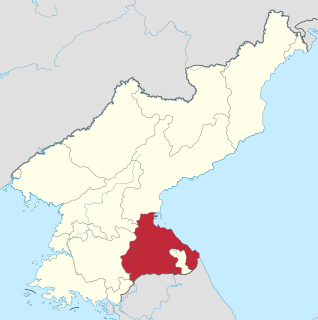
Kangwon Province is a province of North Korea, with its capital at Wŏnsan. Before the division of Korea in 1945, Kangwŏn Province and its South Korean neighbour Gangwon Province formed a single province that excluded Wŏnsan.

Heaven Lake is a crater lake on the border between China and North Korea. It lies within a caldera atop the volcanic Changbai Mountain, a part of the Baekdudaegan mountain range and the Changbai mountain range. It is located partly in Ryanggang Province, North Korea, at 42.006°N 128.057°E, and partly in Jilin Province, northeastern China.

The Taebaek Mountains are a mountain range that stretches across North Korea and South Korea. They form the main ridge of the Korean peninsula.

Mount Kumgang or the Kumgang Mountains are a mountain/mountain range, with a 1,638-metre-high (5,374 ft) Birobong peak, in Kangwon-do, North Korea. It is about 50 kilometres (31 mi) from the South Korean city of Sokcho in Gangwon-do. It is one of the best-known mountains in North Korea. It is located on the east coast of the country, in Mount Kumgang Tourist Region, formerly part of Kangwŏn Province. Mount Kumgang is part of the Taebaek mountain range which runs along the east of the Korean Peninsula.

The Blue House is the executive office and official residence of the South Korean head of state, the President of South Korea, located in the Jongno district of the capital Seoul. The Blue House is in fact a complex of multiple buildings, built largely in the traditional Korean architectural style with some modern elements. The Blue House is the most protected official residence in Asia.

Korea is located on the Korean Peninsula in North-East Asia. To the northwest, the Amnok River separates Korea from China and to the northeast, the Duman River separates Korea from China and Russia. The Yellow Sea is to the west, the East China Sea and Korea Strait is to the south, and the Sea of Japan is to the east. Notable islands include Jeju Island (Jejudo), Ulleung Island (Ulleungdo), and Liancourt Rocks.
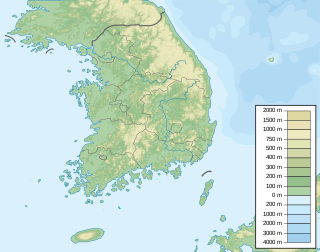
Manisan is a mountain in Incheon, South Korea. It is situated in Ganghwa County and is the highest peak on Ganghwa Island. Manisan has an elevation of 469.4 m (1,540 ft). There is a popular hiking trail to the summit; at the summit is Chamseongsdan, an altar where Dangun performed ritual ceremonies.
Manisan is a mountain of South Korea. It has an elevation of 640 metres.

Gyeyangsan is a mountain located in Incheon, South Korea. It has an elevation of 395 m (1,296 ft). Its elevation makes it the second highest in Incheon, next to Manisan (Incheon) which is located in Gwanghwa Island. From the top of the mountain, Gimpo Airport is visible, with a view of Seoul to the east, various islands such as Gwanghwa Island and Yeongjongdo in the west, Goyang in the north, and a whole view of Incheon to the south. It is considered a symbol representing Incheon.
The 2014 Asian Games torch relay was held from August 13, 2014 and travel through 70 cities for 5,700 km until the opening ceremony. Two cities were elected as the international torch relay leg, they are New Delhi, India on August 9, 2014 and Weihai, China on August 12, 2014, this also marked the first time the Games hosted by South Korea's city to have international torch relay.

Sahaya is a 2019 Philippine television drama series broadcast by GMA Network. Directed by Zig Dulay, it stars Bianca Umali in the title role. It premiered on March 18, 2019 on the network's Telebabad line up replacing Onanay. The series concluded on September 6, 2019 with a total of 122 episodes. It was replaced by Beautiful Justice in its timeslot.
















